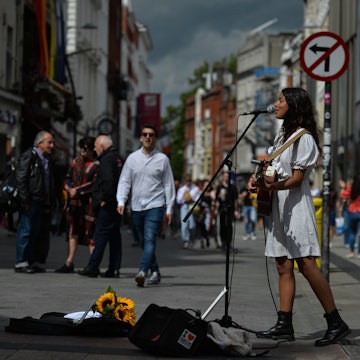

Walking is one of the best ways to explore Dublin © Westend61 / Getty Images
Getting around Dublin without a car is easy. The compact city is well served by an efficient network of buses, trams and trains that connect the city and the suburbs.
No more than a few square kilometers, the flat city center is highly walkable and cyclable too, with public bike-sharing schemes making bicycles accessible to everyone. Comfortable shoes and rain gear are a smart choice at any time of year.
Explore Dublin city easily on foot
Dublin is easy to get around on foot and is becoming increasingly pedestrian-friendly, with several new car-free zones. It's easy to walk between many of the major tourist attractions thanks to the city's compact size and flat terrain, as well as the dozen or so central bridges that criss-cross the River Liffey, connecting the north and south sides of this vibrant capital.
Getting around on two wheels
A growing network of bike lanes and cycle paths has made Dublin more accessible to those who prefer to explore on two wheels, although nervous cyclists may find some motorists less respectful than they should be.
The city hosts several popular bike-sharing schemes, allowing you to sign-up, hop on and pedal your way across town and further afield. You can pick up a bicycle anywhere you spot one and drop it off at another point throughout the city.
NOW dublinbikes is the most prolific operator, with 1600 grey bikes parked at 115 designated bike stations around the city. Easy and affordable, the first 30 minutes are always free, after which you’ll be charged a small fee based on the length of your journey. One-day and three-day tickets are available, as well as an annual subscription for unlimited usage, and the bikes must be returned to one of the official bike stations.

Dublin also has two stationless bike schemes, Moby and Bleeper, that use smartphone and GPS technology to allow you to hire a bike from anywhere you spot one and drop it off at any bike rack on public property within the operating zone. Download the relevant app, enter a few details to register your account, and you can unlock a bike with your phone. All available bikes can be viewed and unlocked within the app with bikes available 24 hours a day, seven days a week.
Moby also offers electric bikes, and several e-bike schemes operate throughout the wider suburbs too, including Tier in north county Dublin and ESB bikes in 14 commuter locations. E-bikes can be hired through their dedicated apps.
There are plenty of places to park your bike throughout the city, but always check it’s thoroughly locked as bike theft is a problem in Dublin. Avoid leaving it on the street overnight as even the toughest lock can be broken.
The bus network allows you to traverse the city on a budget
A fleet of bright yellow Dublin Bus doubledeckers plies Dublin’s streets, connecting most parts of the city center to the outer suburbs through a network of over 100 routes. A convenient and affordable way to get around, most routes run from 6am (later on Sundays) until around 11:30pm in the evening, with some 24-hour services and Nightlink routes running seven days a week.
There are over 5000 yellow bus stops and bus shelters throughout the greater Dublin area, and most feature real-time displays. Bus stops are numbered and the Dublin Bus website and handy app allow you to view all routes, stops, fares and timetables. Sometimes the timetable is more of an advisory than a guarantee, so don't panic if your bus doesn't show up exactly as scheduled.
Go-Ahead Ireland runs an additional 30 routes, using the same bus stops and fare system, with its striped blue and yellow livery the only visible difference. The Transport for Ireland website or app will help you to plan any journeys in Dublin and see real-time arrivals at your nearest stop.
For all bus services in Ireland you need to put out your hand to let the bus driver know that you want them to stop. Buses display their number and final destination clearly on the front, though if you’re unsure about a route simply ask the driver – they are generally very friendly and happy to answer a query when they are at a stop.
Fares are paid to the driver when you board and coins are accepted, though change isn’t given so try to have the exact fare ready. Fares are calculated on distance traveled and are considerably cheaper if you sign up for a pre-paid Leap Card (more details below). A special 90-minute fare of €2 now applies to most journeys in the Dublin area, allowing you discounted travel on buses, Luas (tram) and DART within that time frame. Be sure to sit on the top deck if you fancy a free sightseeing tour while in transit.
Give your wallet a break with these free things to do in Dublin.

Take a trip to Dublin's seaside suburbs on the DART
The Dublin Area Rapid Transit, DART, is a suburban rail network running through the city center and along the Dublin coastline from Malahide and Howth in north Dublin southwards as far as Bray and Greystones in Co Wicklow. Serving 31 stations, it’s swift, reliable and very comfortable. Running every 10 to 20 minutes from around 6am to midnight, with Sunday services from 9am to 11pm, it’s generally faster than the bus, though carriages can be full at rush hour.
With several city center stations, Pearse Station is handy for central Dublin south of the Liffey, and Connolly Station for north of the Liffey. Day trips to Dublin’s beaches and harbor towns are a cinch on the DART, with the southern route known for its picturesque journey along the coast. Handily, bikes can be taken on board free of charge on off-peak DART services. The network connects with national, commuter and regional train services at Heuston Station, Connolly Station and Pearse Station in the city center. For more route information, check out Irish Rail.
Glide around the city on the Luas
Sleek, modern and reliable, the Luas is a twin-line electric tram system connecting Dublin's city center with its suburbs. Trams run every 3-4 minutes at peak times and every 15 minutes at night. The Green Line runs from Broombridge in the north of the city down along O’Connell St and St Stephen’s Green south to Brides Glen (via Ranelagh and Dundrum). The Red Line runs from Saggart in the west via Heuston Station (handy for Phoenix Park) to the 3Arena.
Trams run from 5:30am to 12:30am Monday to Friday, 6:30am to 12:30am on Saturdays, and 7am to 11pm on Sundays and public holidays. Tickets must be bought in advance of boarding a tram – ticket machines are at every stop or you can tap-on and tap-off with a pre-paid Leap Card. A typical short-hop fare (around four stops) is €1.70.
Taxis and ride-share apps
Plentiful by day, often elusive late at night, Dublin’s taxis are clean, regulated and relatively affordable. Taxis can be any model or color, though all sport bright yellow roof signs with green and blue door signage. They can be hailed on the street (if the roof light is on it means they’re available to take a fare) or at the numerous taxi ranks around the city, including on the corner of Abbey and O'Connell Streets, College Green, in front of Trinity College, and St Stephen's Green at the end of Grafton St.
Taxi drivers are legally required to accept payment by card and fares depend on the length of the journey, time of day and number of passengers. Despite this legal requirement, some drivers will ask for payment in cash – check that you can pay by card before getting in. Only licensed taxi drivers are permitted in Ireland, and some internationally popular ride-sharing apps are not available or are only in use for hailing taxis. Uber operates in Dublin, but all vehicles will be licensed.
All taxi fares begin with a minimum charge of €4.20 (€4.80 from 8pm to 8am), followed by €1.30 per km/€0.46 per minute thereafter (€1.71/0.60 from 10pm to 8am), with a third tariff kicking in after 14.5 kilometers or 42 minutes. In addition to these, there are a number of extra charges – €1 for each extra passenger and €2 for pre-booking. There is no charge for luggage.

Driving in Dublin is rarely worth the stress
Cars are out of fashion on Dublin’s streets with expanding cycle lanes and newly pedestrianized areas removing parking spaces and necessitating new (and often frustrating) one-way systems. Traffic moves slowly, and with expensive parking, both on the street and in car parks, there’s a strong argument for leaving your car at your accommodation and walking or using public transport.
There are no free parking spots anywhere in the city center during business hours (7am to 7pm Monday to Saturday), but there is plenty of paid on-street parking, priced according to zone: €3.50 per hour in the yellow (central) zones decreasing to €0.80 per hour in blue zones. Register for payments at Parking Tag or buy a ticket from a ticket machine located on the street – always check the street signs, as some areas require payments beyond 19:00, as well as on Saturdays and Sundays.
Clamping of illegally parked cars is thoroughly enforced, with an expensive release charge of €125. Parking is free after 7pm Monday to Saturday, and all day Sunday, in most metered spots (unless indicated) and on single yellow lines. Car theft and break-ins are an occasional nuisance, so never leave any valuables in your car. When you're booking accommodation, check if they have parking facilities – a lot of city center hotels don't have on-site parking for guests.
You’ll find many supervised multi-story car parks in the city center, charging around €4 per hour. Pre-booking online offers better value and many have a low-cost day or evening flat rate.
A car is often the best option for traveling outside of Dublin and can be rented from one of the main agencies in the city. Book in advance for the best rates, especially at weekends and during summer months, when demand is highest.
People aged under 21 are not allowed to hire a car and the majority of rental companies insist that drivers are at least 23 and have held a valid driving license for a minimum of one year. Many rental agencies will not rent to people over 70 or 75. Motorbikes and mopeds are not available for rent in Ireland.
See more of Ireland on one of these classic road trips.
Getting to and from the airport in Dublin
Dublin Airport is 10 km north of Dublin City Center, and while there is no train connection, several bus routes travel regularly to the city center and beyond. The journey takes approximately 30 minutes. Return fares with Aircoach, which departs every 15 minutes 24 hours a day, cost from €9.00 with pre-booking recommended. The Airlink Express Airport Transfers Hub provides additional options for transport between Dublin Airport and the city, including two Express Bus services. Aircoach buses stop at numerous sites in the city center, leaving you a short walk from Dublin's main transport networks including train, tram and Dublin Bus. Taxis and car hire are widely available from both airport terminals.

Getting a Leap travel card will save you money
If you’re planning on using Dublin’s extensive public transport, then a Leap Card is the smartest investment. The pre-paid smart card offers reduced fares (31% on single fares) across all Dublin buses (including Airlink and Nightlink), DART, Luas (tram), and commuter trains and saves you rummaging for exact change. Leap Cards can be bought from newsagents around the city, including at Dublin Airport, and from ticket vending machines at Irish Rail stations.
Register your card online and top it up with credit at shops, ticket machines or with the official phone app. For DART, Luas (tram) and suburban train journeys, simply swipe your card on the platform before boarding, and again when you disembark.
Whenever you board a bus, place your card on the fare reader beside the driver.
Accessible transport in Dublin
Dublin’s compact city center is mostly flat. Bar a few cobblestoned areas it’s relatively accessible and the public transport network makes it an attractive destination for people with mobility issues. While most DART stations are disability-friendly, DART and train services require 24 hours' notice before boarding with a wheelchair, and lifts to platforms are frequently out of service. Dublin buses are wheelchair-accessible, but Luas is the most accessible of all transport options.
Wheelchair-accessible taxis have a wheelchair icon on their roof sign and have been modified with specialist equipment including ramps, wheelchair anchorages and suitable seatbelts. Check out Irish Wheelchair Association and Trip-Ability for information. For more information, download Lonely Planet's free accessible travel guide.
















